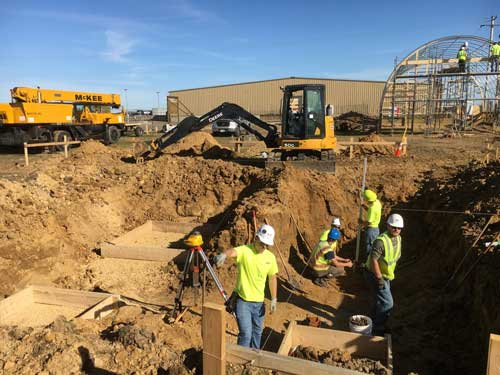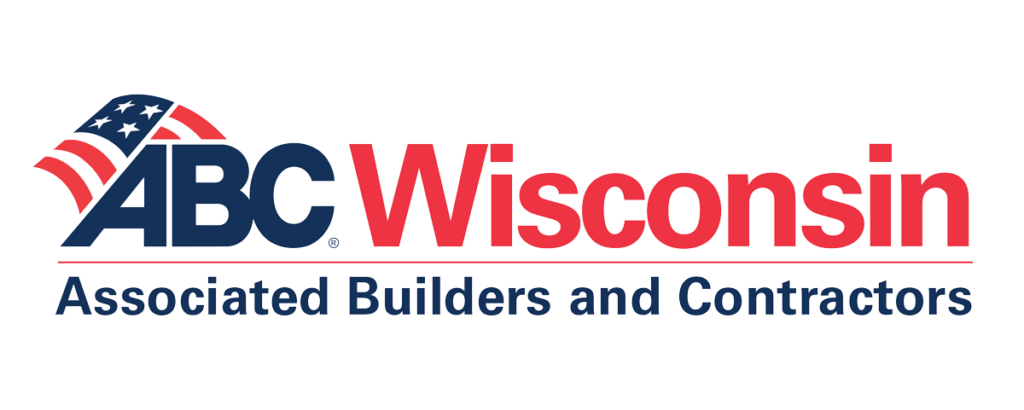How do you educate 30 inexperienced college kids to a point where they will become good construction project managers? You provide them a real-world construction site with skid steers, cranes and excavators. This is what the Building Construction Management and Building Construction Safety Management programs at the University of Wisconsin-Platteville are doing with the new commercial construction laboratory. It’s a two-story, all steel super structure, designed to code by a professional engineering company.
“It’s becoming a giant erector set that goes up every semester and it comes back down,” said program Co-director Mark Albers, who conceptualized the lab. “It’s a consistent controlled learning experience for our students,” said Albers, who took over the Associate Professor position in the Building Construction Management program several years ago and was somewhat dismayed that the laboratory was merely residential. He said that was educational, but with 98 percent of his graduates working in commercial construction, he knew the emphasis needed to change.

“I saw how starkly, inexperienced the students were. Half of the students had little hands on experience. They had never poured concrete. They had never seen how a hole was drilled or how a steel beam is attached with welding or bolting,” Albers said. “I noticed that a lot of the students didn’t know what I was talking about. No matter how simple I had boiled it down. This is a desire to try to address that,” he said.
New construction management employees are a big investment that can take three years to make it through the learning curve. With this lab, graduates are paying their way for contractors by year two. “It’s kind of forcing them [students] to understand it’s not just about looking at a set of drawings and coming up with an estimate, there’s a lot of skill that goes into this,” Albers said.
“We’re trying to shorten the return on their [contractors’] investment in our graduates. It’s a shorter window from once they hire them to where they’re very productive,” Albers said. “Within a year, they’re managing projects as opposed to investing three years of just teaching them the very basics,” Albers added.
“Students are always able to ask a question or start a discussion without the worry of interfering or slowing down a schedule,” said Lidia Frias, a senior from Iola, Wisconsin. “The goal is to make sure we get the most out of our semester on site, while emphasizing safety and proper technique,” Frias said.
The Commercial Construction Laboratory is the only known program in the U.S. where the students get real experience on an actual commercial construction site. But it doesn’t just benefit the construction management students, it benefits the construction safety management students, under the direction of Lab Co-Director and Assistant Professor Mark Miner, who are able to learn and coach the management students on the real dangers of construction. The two programs are co-dependent on the Lab.
“We’re nothing in this construction program without the Safety Program and vice versa. If we take away this lab from the safety people, we’re just another safety program that knows the OSHA book and that’s it,” Albers said.
Having the idea for the lab was one thing. Making it happen was something entirely different, with many significant obstacles looming, including no land, a lack of money and no heavy equipment to move materials around.
“It’s not a time within the UW or in education to be asking for funding, especially for anything new,” Albers said. “So that was one of the first obstacles. I was told, ‘We think this is a great idea, but we don’t see any funding coming your way to ever implement this.’”
Albers began to network and make cold calls. He met with a local businessman over a couple of donuts and the next thing he knew he had a lease on four acres of land for four years for a dollar. Next, he was able to secure the use of a forklift, crane and skid steers. Many contributions came from ABC members. Once the university saw Albers’ progress, they provided a few dollars to assist the program. That’s where the program stands now.
After a couple of semesters, the lack of revenue will become a challenge. Donations are drying up at a time when the program will get more complex. Albers would like the industry to help sustain the program.
“We’ve probably tapped out the local investments that we can. Going forward now, we would like other contractors who feel this has some benefit to them to be open to the idea of investing in this program,” Albers said.
Albers said it would be ideal if contractors could commit $1,000 each for four years. If he could get 100 contractors on board, the program could assume some expenses for equipment currently on loan. He said contractors could also help by donating materials or coming in and speaking to a class for an hour.
Student Brody Beard said the program has been very beneficial to students. “Actually doing the building and learning how the process works for putting up [the] structure is amazing,” Beard, a senior from Dixon, Illinois said. “I think every student should have these hands-on experiences. Hands-on work is truly the best form of education for a BCM/BCSM student,” he added.
“They truly appreciate the trades when they get out of here. Our goal is not to make them tradesmen,” Albers said. “They don’t have to be able to do finish concrete or be a welder, but they’ll be exposed to all those things and they’ll appreciate the guys out in the field.”
“My appreciation for not only field workers, but also for everyone involved in scheduling and coordinating construction, has grown immensely,” said Frias. “Our lab is the perfect setup for me and the other students to have a chance to get our hands dirty in an environment built for learning,” Frias said. “It is a great feeling knowing that I get to contribute to something tangible and I am excited to see how the lab will grow in the future,” she said.











